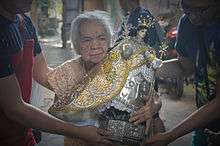Santa Marta de Pateros
Santa Marta de Pateros is a title given to the biblical figure Martha of Bethany based on the belief that Martha appeared in the village of Pateros in the Philippines in the 17th century.
| Santa Marta de Pateros "Rosas ng Pateros" | |
|---|---|
 Imahe ni Santa Marta na pinipintuho ng maraming tao sa kanyang Dambana, Parokya ng Pateros | |
| Venerated in | Roman Catholic Church |
| Major shrine | Diocesan Shrine of Saint Marta, Parish of St. Roch, Pateros, Metro Manila, Philippines |
| Feast | Second sunday of February (Town Fiesta) and July 29 (Feast day of Catholic Church) |
| Attributes | Holding a palm leaf on right, cross on left and stepping on a crocodile. |
| Patronage | People of Pateros, duck raisers and alfombra/abolorio makers |
Legend
The legend says that Saint Martha (the saint who tamed the Tarasque) answered the prayers of the people of Pateros to help them with a giant crocodile that was pestering the river of Pateros by attacking the ducks. At that time, during the 1700s, ducks (whose eggs are used to make the local delicacy (balut)) were abundant in the river through Pateros. In Tagalog, the word for duck is "pato"; the people doing duck raising are thus "pateros". The people of Pateros sought the intercession of St. Martha to eliminate the crocodile. One evening, under a full moon, a bayani (local hero/unknown) was on his way to the river to slay the creature when he saw a brilliant light showing the figure of the beloved saint. Since then, the creature was never seen again and the duck industry flourished. The people of Pateros attributed this miracle to Saint Martha and a grand fluvial celebration was held to commemorate this since then.

Pateros Fiesta
In earlier times (1700s to 1960s) the fiesta in honor of Santa Marta de Pateros had no fixed date; it was celebrated in either January, February, or March. The Poderes de Sta. Marta, whose members are old men devoted to the patroness, would choose a date within these months, taking into consideration the abundance of harvest of balut and rice grain, then choosing an evening with a full moon to serve as the light for the Pagoda sa Ilog (the fluvial parade) since there was no electricity at that time. In the 1960s, the date was fixed to second Sunday of February to avoid confusion and in consideration of the economic and environmental changes to the town. It was also said that during that era Monsignor Sicat, the former parish priest, moved the celebration to July 29.
Pamisa De Gracia
The "Pamisa De Gracia" opens every town fiesta. Pamisa De Gracia is a way of thanksgiving for an answered miracle, birthday or anniversary through Saint Martha. The family who will organize borrows the images of Saint Martha, Saint Roch and Saint Isidore from the houses of their camareros and camareras. A sunduan (fetching) procession will start on a Friday at the house of the caretaker of the image where the image of St. Isidore is, to be accompanied by a brass band, followed by the house where the image of St. Roch is, and finally St. Martha. Saturday will be the prayer vigil for the host family, and Sunday will be the procession from the house of the host family to the Diocesan Shrine of St. Martha, Parish of St. Roch where the thanksgiving mass will be held. After the mass, a procession will follow from the church to the family's house and then back to the houses of the caretakers of the image. "Pamisa" (holding of mass) is held anytime a family borrows the images.
Diocesan Shrine of St. Martha and the Parish of San Roque
In 2008, Rev. Fr. Orly Cantillon, the pastor of the Parish of San Roque in Pateros, along with the Poderes de San Marta de Pateros, filed a petition to Bishop Francisco C. San Diego D.D., Bishop of the Roman Catholic Diocese of Pasig, requesting that the Parish of San Roque be titled the Diocesan Shrine of St. Martha. The request was granted and the decree was presented December 2008. The proclamation was made official February 7, 2009, followed by the annual fiesta celebration the next day.
The diocesan shrine is the only shrine in southeast Asia. The shrine has been proposed as a National Shrine of the Philippines, a proposal that is still in process As of November 2014.
Sources
- Diocesan Shrine of St. Martha, Parish of St. Roch Website (Filipino)
- Diocesan Shrine of St. Martha, Parish of St. Roch Facebook page (Filipino)
- Poderes de Santa Marta de Pateros Facebook page (Filipino)